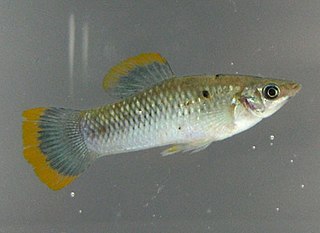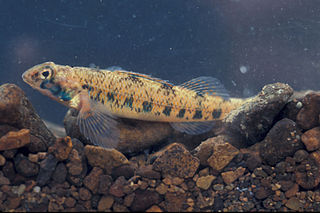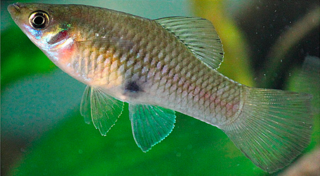
Poecilia is a genus of fishes in the family Poeciliidae of the order Cyprinodontiformes. These livebearers are native to fresh, brackish and salt water in the Americas, and some species in the genus are euryhaline. A few have adapted to living in waters that contain high levels of toxic hydrogen sulfide and a population of P. mexicana lives in caves.

The sailfin molly is a species of fish in the genus Poecilia. As with the other types of mollies, P. latipinna is a livebearer, giving birth to free-swimming babies, a trait they share with similar fish species such as guppies, platies and swordtails. Sailfin mollies typically inhabit both freshwater and brackish waterways along the East Coast of the United States, from North Carolina south to Florida, and around the Gulf of Mexico to Texas, and south to the Yucatán Peninsula of México. Given their preference for more brackish water conditions, mollies are often found within just a few yards or miles of the ocean, inhabiting coastal estuaries, lagoons, river deltas and swamps, as well as tidal areas with a regular inflow of oceanic minerals and nutrients mixing with inland freshwater sources.

The variable platyfish, also known as variatus platy or variegated platy, is a species of freshwater fish in family Poecilidae of order Cyprinodontiformes. A livebearer, it is native to southern Tamaulipas and northern Veracruz states in northeastern Mexico. It is a popular fish in the aquarium trade due to its prolific breeding, as are hybrids with other members of its genus, most notably the southern platyfish.

Poecilia sphenops is a species of fish, of the genus Poecilia, known under the common name molly; to distinguish it from its congeners, it is sometimes called short-finned molly or common molly. They inhabit fresh water streams and coastal brackish and marine waters from Mexico to Colombia. The wild-type fishes are dull, silvery in color. The molly can produce fertile hybrids with many Poecilia species, most importantly the sailfin molly. The male mollies generally tend to be mildly aggressive.

The butterfly splitfin or butterfly goodeid is a bony fish from the monotypic genus Ameca of the splitfin family (Goodeidae). It was formerly found throughout the Ameca River drainage in Mexico; the type locality is Rio Teuchitlán in the vicinity of Teuchitlán, Jalisco. The species was only ever found in an area about 10 miles (15 km) in diameter.

Poecilia velifera, known as the Yucatan molly and also as the giant sailfin molly amongst aquarists, is a very large Livebearer that lives in coastal waters of the Yucatan peninsula. These live-bearer (Poeciliidae) fish are particularly well known for both the extreme size variation among males, and the sexual dimorphism between males and females in both body shape and behavior.

Pseudanthias parvirostris, the sunset anthias is a species of marine ray-finned fish in the subfamily Anthiinae of the family Serranidae, the groupers and sea basses. It is found in the Indo-West Pacific Ocean. It occasionally makes its way into the aquarium trade. It grows to a size of 7.5 cm in length.

The Indonesian angelshark is a rare species of angelshark, family Squatinidae, known only from a few specimens collected from fish landing sites in southern Indonesia. It is thought to inhabit the deep waters of the continental slope. Reaching at least 1.34 m (4.4 ft) long, this species has a flattened, ray-like shape and a well-developed tail and caudal fin. It is characterized by the absences of fringes on its nasal barbels and thorns down the midline of its back, as well as by its relatively plain grayish-brown dorsal coloration with dark saddles beneath the dorsal fin bases and a black leading margin on the underside of the pectoral fins. The International Union for Conservation of Nature (IUCN) has classified it as Critically Endangered due to significant fishing pressure.

The blueside darter is usually found in the Tennessee River drainage in Tennessee, Alabama, North Carolina, and Virginia, and less commonly found in Bear Creek, Shoal Creek, and Barren Fork.
Percina phoxocephala, the slenderhead darter, is a species of freshwater ray-finned fish, a darter from the subfamily Etheostomatinae, part of the family Percidae, which also contains the perches, ruffes and pikeperches. It is found in North America in the central Ohio and Mississippi River basins, to northeastern South Dakota and the Lake Winnebago system in Wisconsin, and as far south as the Red River in eastern Oklahoma and northeast Texas, typically in small to medium size rivers. It is a colorful species, with an average length of 6 to 9 centimeters. Males take on a deeper hue during the breeding season. It feeds on insect larvae and other small invertebrates, and spawns between April and June. It is a common fish with a very wide range and the International Union for Conservation of Nature has classified its conservation status as being of "least concern".

Zoogoneticus tequila, Tequila splitfin or simply Tequila fish, is a species of goodeid fish from Mexico. The specific epithet, tequila, derives from the Tequila Volcano, which looms near the type locality.

The liberty molly is a fish species from El Salvador. It is one of the short fin molly species in the Poecilia sphenops complex, and had been often regarded as a variety of P. sphenops until recently.
'Pseudanthias ignitus, the flame anthias or flame basslet is a species of marine ray-finned fish, an anthias from the subfamily Anthiinae part of the family Serranidae, the groupers and sea basses. It is found in the Indo-Pacific region.

Poeciliopsis prolifica, or the blackstripe livebearer, is a species of small freshwater fish in the family Poeciliidae. It is endemic to Mexico. It is a viviparous species and the female can have several clutches of young developing internally at the same time, hence the specific name prolifica, from the Latin proles, "offspring" and ferax, "rich, fruitful" in reference to the great number of young produced.

Limia melanogaster, the black-bellied or blue limia, is a poeciliid fish from Jamaica. It inhabits fast-flowing streams. It is a rare livebearer in modern fishkeeping.

Poecilia kykesis, also known as the Usumacinta molly, Petén molly, spiketail molly, or swordtail molly, is a poeciliid fish species native to the fresh and brackish waters of Mexico, Guatemala, and Belize. It belongs to the sailfin molly clade, with males exhibiting an enlarged dorsal fin. The species has a notably controversial naming history, with the former name, Poecilia petenensis, now referring to a short-finned molly species. It is a livebearer sometimes kept in aquaria.
Poecilia petenensis, the Petén molly, is a poeciliid fish species endemic to Guatemala.

Poecilia gillii, Gill's molly, is a herbivorous livebearer fish distributed throughout Central America. It is found in both moving and still water as well as in both freshwater and brackish habitats. Populations of this species differ in color, size, and morphology.

Phallichthys amates, the merry widow or merry widow livebearer, is a livebearer fish from Central America, the largest and most widespread in its genus. Two subspecies range from Guatemala to Panama. Distinguishing features include the dark dorsal fin edge, a stripe through the eye, and an oversized male copulatory organ (gonopodium).
Poecilia catemaconis, the bicolor molly, is a livebearer fish from Mexico.















